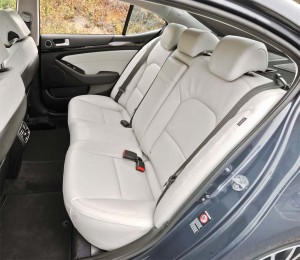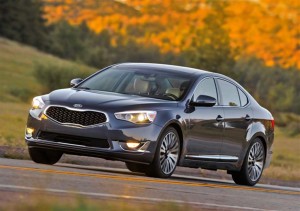As it rolls out the new Cadenza, Kia says it hopes to break into a new niche between the conventional mainstream and more luxurious segments.
The Kia Cadenza becomes the most expensive product the Korean maker has ever offered, with a well-equipped model pushing above the $40,000 mark. The launch echoes the strategy of Kia’s sibling brand, Hyundai, which has also expanded upwards from its traditional, econobox roots.
During the launch of the new Cadenza, Michael Sprague, Kia’s vice president for marketing communications, said the habits of American car buyers are changing. Fewer motorists actually want to move up and own a luxury brand, only 8% today compared to 22% before the recession undermined consumer confidence. Instead car buyers are looking for a good value and they want luxury features and the latest technology in a less ostentatious package.

The Cadenza's wheelbase is 5 inches longer than the midsize Optima - which means plenty of interior space.
Kia isn’t the only maker that perceives this new niche. Among the potential competitors are such products as the Buick LeSabre, Toyota Avalon, Nissan Maxima and even the Acura TL and Lexus ES.
But Sprague said he is optimistic of gaining a foothold against those better-established rivals because, “We offer the best value.”
The new sedan sits on a wheelbase that is five inches longer than that of the current Optima sedan.
Prices for the Cadenza will start at $35,100 and top out at $41,100. For the money, motorists will get a sedan that emphasizes a more quiet and luxurious ride, as well as a V-6 engine that produces 293 horsepower — as well as a 10-year/100,000 mile warranty.
Sprague said the Korean maker’s success since the introduction of the popular Kia Soul in 2009 laid the groundwork for the introduction of the Cadenza. Step by step Kia has rebuilt its model line-up, which once could best be described as drab, with new vehicles that are more stylish, sporty and well-equipped.
Vehicles like the quirky Soul, as well as the Sorento and Optima, have rebuilt the company’s image and reputation with a wide swath of customers, Sprague said. Thus Kia believes there is room to grow in the space between what might be described as more modest nameplates and the up-market luxury brands.
The upstart Korean brand has been selling cars in the United States for 18 years and in 2012 delivered 550,000 new vehicles, making it the eighth best-selling automotive brand in the United States — ahead of several well-established nameplates such as Chrysler, Volvo and Mazda, Sprague noted.
In addition, the residual value of the cars Kia sells in the United States has been rising steadily over the past five years and Kia’s transaction prices – what customers actually spend after working in incentives and options — have been climbing steadily, as well. Of the 150,000 Kia Optima’s the company sold in the U.S., fully two-thirds, had transaction prices of more than $25,000 – above the industry average.
Meanwhile, the age of the typical Optima buyer is 48 years of age and has a household income of more than $100,000.
Sprague said Kia expects relatively modest growth this year after four years of big gains but is working to elevate the experience of the customers who walk into one of the company’s 795 dealerships in the U.S.
However, it will continue to launch new products this year as it rolls out both coupe and five-door versions of the Forte and a refreshed version of the Optima, as well as Cadenza.
“We’re not in this for the numbers from the next 60 or 90 days. It’s about what happens in the next one, two or three years,” said Kia Vice President Tom Loveless.

